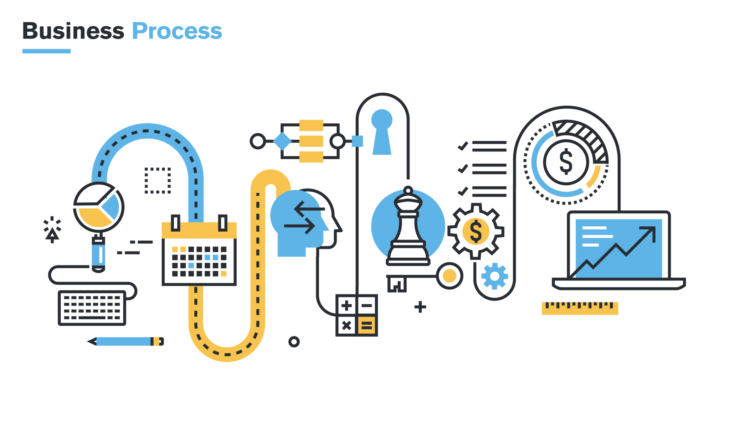Business processes form the foundation of any company. They are the day-to-day tasks in the company, and how well these procedures operate can spell the difference between an average and a great company.
However, as your company grows and changes, the processes become more complex as more people become involved in the company’s daily operations and customers’ expectations begin to vary. To continue improving and to ensure that the company is scalable, streamlining business operations is highly crucial. It is a great way to increase the value of your company both for now and tomorrow.
Contents
What is a Business Process?
- Before you can improve on your business process, you need to first understand what it is. Business processes refer to the series of repeatable day-to-day actions carried out by individuals in a company to accomplish a specific business goal. Generally, the business process is divided into;
- The operational aspect of the company which includes creating new products/services for sponsors or stakeholders, taking customers’ orders, etc.
- The management part of the company which includes employee administration, budget, and corporate oversight, and
- Other supporting procedures, such as recruitment, technical support, recruitment, etc.
- Also, a business process can be formal or informal. Also known as a procedure, a formal business process is documented either on paper or software. On the other hand, informal means that the process exists in the company but have not been documented.
- The performance of business operations significantly affects the success of the company. If you have efficient and streamlined procedures, it will help your business by;
- Generating higher productivity and profits
- Boosting employees’ morale. With a streamlined business process, your employees won’t have to work on tasks that do not contribute to business growth. Also, they will be better equipped to handle their various tasks as they’d have been trained in business administration courses online.
- Offering your customers more satisfied. A streamlined business process will provide top-quality products/services with lower defects, faster delivery time, and better customer service. This will, in turn, lead to happier customers and strengthen your brand image.

Source: futurelearn
Streamlining Business Process
Business operations require continuous improvement; you should never be simply content with your operations. The goal is to keep getting better and better, and optimizing your business procedures will ensure that your company keeps operating at peak efficiency.
Therefore, as you could have guessed, streamlining business process refers to improving your company’s efficiency by adopting better methodologies, removing steps that do not add value, or employing new technology.
Here are some scalable and feasible ways to optimize your business operations:
1. Map out the Process
How can you efficiently optimise your business process without fully knowing what it consists of? Once you’ve decided on the business operation you want to improve; it is best to get a comprehensive understanding of the procedure.
Depending on the operation, there are various process mapping tools you can use, such as flowcharts, Swim Lane Diagrams, value stream maps, or SIPOC. One of the simplest ways to map out the process is by creating a detailed physical document with pen and paper. However, as the report isn’t on software, it is harder to share and get feedback on.
So, you can use the Flowchart, software particularly for developing process diagrams online. Some business operations usually spread over various sub-sections, so be sure to explore the process thoroughly. If possible, you should seek the help of those who are frequently involved in the operation, so you don’t miss out on anything.

Source: timelinepi
2. Process Analysing
After you’ve mapped out the process, the next thing is to investigate it to dig out flaws and inefficiencies. There are two different types of analysis, one for problem-solving and the other for optimization.
Problem-solving means that you are trying to identify what went wrong with a particular process and then try fixing it. The problem could be the loss of clients or frustrated clients. In this case, you can use tools like “The 5 Whys” or “Root Cause Analysis” to get to the root of the problem. Also, tools like the “Fishbone Diagram” or the “Cause and Effect Analysis” will help you to determine the cause and the effects of the problem. Using such tools will help you to devise practical solutions to the problem.
Another type of process analysis is optimization. This involves you trying to improve business operations even though they appear to be working just fine. To get a sense of direction for efficient process optimization, you should ask questions such as;
- Are there steps in the process that consume more time than what you think is reasonable?
- Are delays or missed deadlines usually the result of the operation? What is the reason (s) for this?
- What step in the procedure frustrates customers or team members?
- Are there process steps that incur more cost than others? What is causing this cost drive?
- Which step in the operation is the most crucial for the success of product/service output? How can this step be made even more efficient?
It would be best if you considered using some of the business process improvement tools to increase the efficiency of the analysis.
3. Improve on the Process
After identifying the root cause of the problem, creating a solution and optimizing the business process should be your next focus. Here are some of the solutions that can be used to improve business operation.
- Remove Unnecessary Steps: If the process has steps that do not contribute to the end goal or service of the company, you should cut out those steps.
- Adopt New Methodologies: This simply means that you should change the way you operate. For instance, if you notice that the company’s current recruitment methods are time and money consuming, you can come up with a better way of operating.
- Process Automation: The world is now digital, and your business should be too. Try automating the entire business operations or some of the steps within the process through software or technology.
First, you can automate some of the minor daily tasks involved in the process using a tool like Zapier. Instead of manually managing the business’ documents, you can automate to a document management software. Also, if you use an online customer support tool, you can automate the client communication, especially with replies.
- Business Administration Courses: Employees are an integral part of business processes, and it is best to work with a knowledgeable staff. One of the ways to optimize business operations is to register staff members who are actively involved in the process for business administration courses online.
This will increase their knowledge of work as a team, efficiently execute the day-to-day operations, and also how to relate, sell to and communicate with clients. With the experience gotten from the business administration courses, the employees will be able to reveal new approaches on how to improve business operations.
- Outsource: You can outsource some of the business procedures to save time and resources. However, the process (or process steps) you outsource shouldn’t be critical to the business. This is because outsourced workers can sometimes be unreliable.
You can outsource time-consuming grunt tasks do not require skill or knowledge such as – scheduling meetings, administrative work, online lead contacts gathering, or scraping information. When you outsource, your regular staff will have more time to focus on process steps that really matter.

Source: projectmanager
4. Implementation
You’ve analyzed the problem, and you’ve identified solutions. Now, you can collaborate with different teams to start putting the theoretical solutions to practice. Even more, it would help if you considered the fact that though the solution works in theory, it might not work in a real-time business setting.
Hence, it is better to start implementing from a small scale and move up from there. Rather than implementing round the company, you can start with one team, and then see how the new solution-based process works as against the old one. Ask questions such as;
- Is the solution working as it should? Why or why not?
- Is it causing effects that weren’t accounted for?
- Are there defects or problems? If no, is there a chance of some developing long-term?
However, it doesn’t stop there. You also have to enforce this new procedure. Typically, old habits die hard, and employees tend to have a hard time adjusting to new methods. But, if you’ve trained your staff members in business administration courses, you won’t have any problem enforcing the new processes. This is because they’d have been taught how to adapt to and manage new processes in an organization.
The Bottom Line
The vital thing here is to continue improving business value, operations, and profits. And to achieve this, you must also be interested in always fixing problems in the business process, and optimization.
If you are interested in learning more about business process administration or even training your employees, you should visit MCI Institute. Such institutes offer online courses that will strengthen your business administration skills, and train your employees to better deal with day-to-day business operations.
